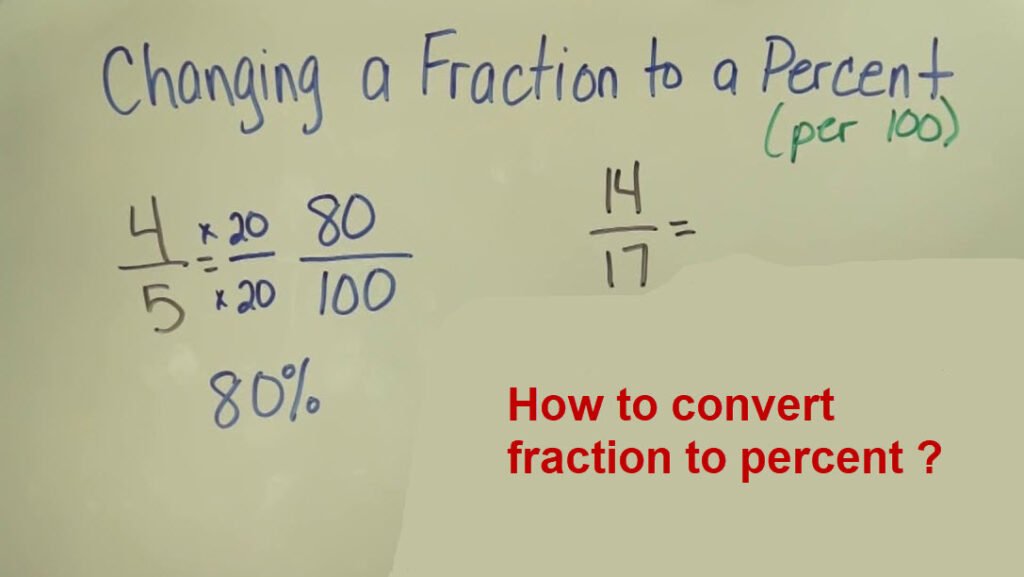What is a Fraction? A fraction consists of two numbers, the top number of which represents the numerator, or unit part, and the bottom number representing the denominator, or total (including the numerator). The total can also be expressed as the bottom number/top number.

Step 1 – Write your fraction in its simplest form
1/2, 1/3, etc. The numerator (top number) is the whole part of your fraction and you can express that as 100%. The denominator (bottom number) tells you how many parts make up your whole. In other words, if you have 4 parts that makeup one whole then each part would be 25% of your whole. So writing out your fraction in its simplest form will automatically tell you what percent of 1 there are in that whole.
Step 2 – Multiply the numerator by 100
To start, take 100 and multiply by 1/3 (The numerator of your fraction) in your head. Easy enough so far, right? Now that you have 100 times 1/3, you can easily determine what whole number your new number represents. This number will be a percent – make sure you know what type of percent it is though! It might be a general percent or maybe even something different like an angle. This particular example results in 33%. Now that we have 100 x 1/3 = 33%, we’ll need to move on!
Step 3 – Multiply the denominator by 100
In order to make a fraction look like a percent, you need to change its value so that both of its values are in terms of hundredths. To multiply by 100, simply add 00 after any number that has two or more digits. For example, if you wanted to convert 5/10 into percent format, you would multiply both sides by 100 because 1000 = 1. So now your fraction looks like 50% (50/100). If we take another example, 0.62/3 = 0.200 = 20%. In other words: – Express each value in hundreds; for example 62=60 and 3=30 – Multiply top and bottom by 100; 200 × 60 × 30 = 120 000 000 – You get 1.
Step 4 – Add up what you multiplied in step 2 and 3
(10,190 + 8660 + 60 + 3) = 18,096. This total is what your potential CPM (cost per mille or cost per thousand impressions) would be on Facebook if you were charged on average $1.80 for each click-through (and you were able to get that average click-through rate). Divide that number by 1000: $18,096 / 1000 = $18.096 CPM; so you would need 186,912 impressions in order to receive a payout of $1.80 per click-through as an average.
Step 5 – Divide by 50
Next, divide by 50. A fraction is really just shorthand for division, so if you have 1/2 of something (also written as 1/2), then you have one part of something divided into two parts—or 0.5. If that’s confusing, here’s an example: Let’s say we want to convert 4 tablespoons into teaspoons.
Step 6 – Add a % sign at the end of your number
In order to change your fraction into a percent, you simply add a % sign at the end of your number. The fraction 12/20 can easily be turned into 20%. So you have changed your fraction into a percent. Keep in mind that any decimal value is automatically converted into a percent. For example, 3.2% will become 3.2%. As long as there are no spaces between your numbers, then just adding an % sign at the end will make all of your fractions equal percentages!
Step 7 – Round off if needed
If you don’t want your readers to know that you’re using an automated tool, round off. Automated tools like Hemingway, ProWritingAid, Grammarly, and Ginger can’t always catch every single error. But it will give you more than enough material to work with when writing a quality draft of your piece. Don’t worry if there are errors in your draft. You can fix them up later with professional help from editors such as ProofreadingPal.
Check your answer
In order to find out what fraction of part of the whole you have, you divide your fraction number by your original whole number. Then multiply that answer by 100. Finally, add percent at the end of your answer. For example: if 1⁄4 of 6 ducks = 1 duck then we get
Practice!
A fraction is an expression of division where one number or quantity is divided by another. For example, 1/4 can be written as 25% (25 divided by 100). You can convert fractions to percentages in a couple of different ways. First, you could find the fraction’s decimal equivalent by dividing its numerator and denominator by 10 each. The decimal equivalent of 1/4 would be 0.25: 25 ÷ 10 = 2 5 ÷ 10 = 0 .5 This means that we’d have 5 parts out of every 10 total parts (5/10), which equals 50%. If you already know your answer is going to come out as an integer, you could divide your numerator and denominator both by two instead.
Conclusion
First off, let’s define what a fraction is. A fraction describes two values divided by another value. For example, 3/5 (Three out of five) can be described as three parts of five parts. The simplest form of fractions are called unit fractions; these are simple fractions where you divide something by 1. These include 1/2, 2/4, 3/6, etc… Converting unit fractions into percentages is as easy as multiplying by 100, i.e.: 1/2 = 50% , 4/8 = 50% , 6/12 = 50% . As you see there isn’t any real complexity here; simply multiply your unit fraction number by 100 and then add % at the end!
